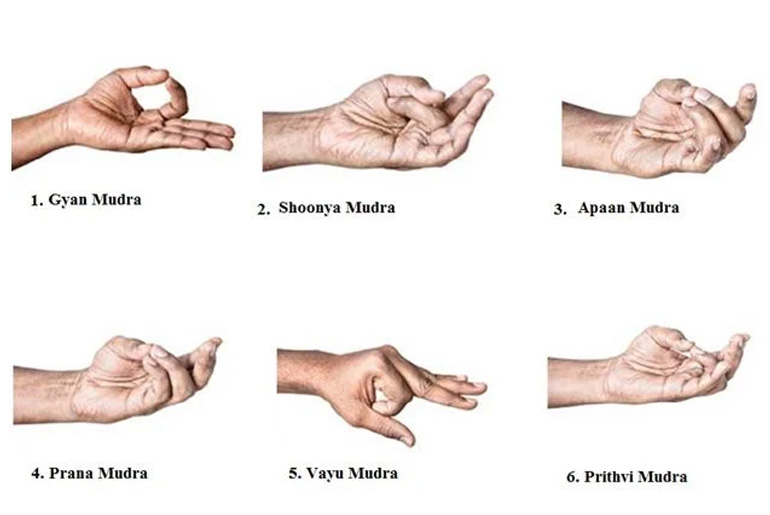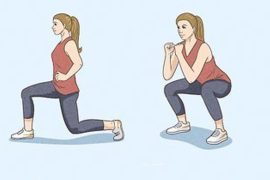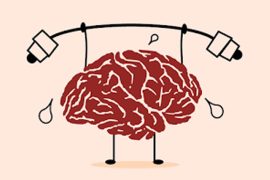Mudras are indeed fascinating aspects of spiritual and yogic practices, deeply rooted in traditions that span Hinduism, Buddhism, and yoga. These symbolic hand gestures, derived from Sanskrit meaning “seal” or “gesture,” are believed to influence the flow of energy in the body and mind. Practiced during meditation, yoga, or pranayama, mudras can be held for varying durations to achieve specific mental or spiritual states. They serve as powerful tools for enhancing concentration, deepening spiritual connections, and promoting overall well-being through their subtle yet profound effects on energy pathways within the body.
1. Shunya Mudra:
The Shunya Mudra, known as the Mudra of Emptiness, is performed by bending the middle finger and pressing it with the base of the thumb, while keeping the other fingers extended and straight. This mudra is associated with the space element and is believed to offer several benefits related to ear health and overall well-being. Practitioners claim that it can help reduce ear problems and dizziness, improve hearing, balance, and inner peace. Some individuals also use the Shunya Mudra to alleviate pain, particularly in the ears, neck, and shoulders. Regular practice of this mudra is said to enhance its effects, supporting ear health and promoting a sense of calm and equilibrium.
2. Apana Mudra:
The Apana Mudra, known as the Mudra of Digestion, is performed by touching the tips of the middle finger and ring finger to the tip of the thumb, while keeping the other fingers extended. This mudra is associated with the earth element and is believed to have several benefits related to digestion and elimination. Practitioners claim that it supports the body’s excretory systems, aiding in detoxification, improving digestion, and regulating elimination processes. It is often used to alleviate issues such as constipation, urinary problems, and menstrual discomfort by harmonizing the flow of energy within the body. Regular practice of the Apana Mudra is thought to enhance its therapeutic effects, promoting digestive health and overall well-being.
3. Prana Mudra:
The Prana Mudra, known as the Mudra of Life, is formed by touching the tips of the ring finger and little finger to the tip of the thumb, while keeping the other fingers extended and straight. This mudra is believed to activate dormant energy within the body, thereby improving vitality and reducing fatigue. Practitioners use the Prana Mudra to boost the immune system, enhance eyesight, and promote overall health. It is also thought to help alleviate symptoms related to vitamin deficiencies and weakness. Regular practice of the Prana Mudra is said to strengthen its effects over time, supporting holistic well-being through its influence on energy flow and balance in the body.
4. Varun Mudra:
The Varun Mudra, known as the Mudra of Water, is formed by touching the tip of the little finger to the tip of the thumb, while keeping the other fingers extended. This mudra is associated with the water element and is believed to offer various health benefits. Practitioners claim that it helps balance the body’s fluid levels and improves blood circulation. It is often used to address issues related to dehydration, dry skin, and hormonal imbalances. Some proponents suggest that regular practice of the Varun Mudra can aid in purifying the blood and improving skin complexion. Like other mudras, consistent practice is thought to enhance its effects, promoting overall well-being through its influence on the body’s energy pathways and elemental balance.
5. Prithvi Mudra:
The Prithvi Mudra, known as the Mudra of Earth, is performed by touching the tip of the ring finger to the tip of the thumb, while keeping the other fingers extended. This mudra is associated with the earth element and is believed to offer several benefits. Practitioners claim that it can improve physical strength, vitality, and body mass. It is often used to support weight management efforts and address issues related to nutrient deficiencies. Additionally, the Prithvi Mudra is thought to aid in alleviating skin problems and promoting overall well-being by enhancing the body’s connection to the earth element. Regular practice of this mudra is believed to enhance its effects, contributing to a sense of stability and grounding.
6. Gyan Mudra:
The Gyan Mudra, also known as the Mudra of Knowledge, is formed by touching the tip of the thumb to the tip of the index finger, while keeping the other fingers extended and straight. This mudra is commonly used during meditation practices and is believed to have several benefits. It is said to enhance concentration, memory, and mental clarity, making it easier to focus during meditation or study. Practitioners also claim that the Gyan Mudra can help alleviate stress, anxiety, and insomnia by calming the mind and promoting relaxation. Additionally, it is thought to stimulate the root chakra, which is associated with stability, grounding, and a sense of security. As with other yoga mudras, regular practice of the Gyan Mudra is believed to deepen its effects over time, supporting both mental and spiritual well-being.
Disclaimer:
The information contained in this article is for educational and informational purposes only and is not intended as a health advice. We would ask you to consult a qualified professional or medical expert to gain additional knowledge before you choose to consume any product or perform any exercise.







